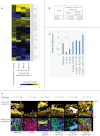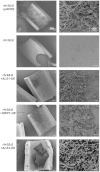Regulatory role of glycerol in Candida albicans biofilm formation
- PMID: 23572557
- PMCID: PMC3622937
- DOI: 10.1128/mBio.00637-12
Regulatory role of glycerol in Candida albicans biofilm formation
Abstract
Biofilm formation by Candida albicans on medically implanted devices poses a significant clinical challenge. Here, we compared biofilm-associated gene expression in two clinical C. albicans isolates, SC5314 and WO-1, to identify shared gene regulatory responses that may be functionally relevant. Among the 62 genes most highly expressed in biofilms relative to planktonic (suspension-grown) cells, we were able to recover insertion mutations in 25 genes. Twenty mutants had altered biofilm-related properties, including cell substrate adherence, cell-cell signaling, and azole susceptibility. We focused on one of the most highly upregulated genes in our biofilm proles, RHR2, which specifies the glycerol biosynthetic enzyme glycerol-3-phosphatase. Glycerol is 5-fold-more abundant in biofilm cells than in planktonic cells, and an rhr2Δ/Δ strain accumulates 2-fold-less biofilm glycerol than does the wild type. Under in vitro conditions, the rhr2Δ/Δ mutant has reduced biofilm biomass and reduced adherence to silicone. The rhr2Δ/Δ mutant is also severely defective in biofilm formation in vivo in a rat catheter infection model. Expression profiling indicates that the rhr2Δ/Δ mutant has reduced expression of cell surface adhesin genes ALS1, ALS3, and HWP1, as well as many other biofilm-upregulated genes. Reduced adhesin expression may be the cause of the rhr2Δ/Δ mutant biofilm defect, because overexpression of ALS1, ALS3, or HWP1 restores biofilm formation ability to the mutant in vitro and in vivo. Our findings indicate that internal glycerol has a regulatory role in biofilm gene expression and that adhesin genes are among the main functional Rhr2-regulated genes.
Importance: Candida albicans is a major fungal pathogen, and infection can arise from the therapeutically intractable biofilms that it forms on medically implanted devices. It stands to reason that genes whose expression is induced during biofilm growth will function in the process, and our analysis of 25 such genes confirms that expectation. One gene is involved in synthesis of glycerol, a small metabolite that we find is abundant in biofilm cells. The impact of glycerol on biofilm formation is regulatory, not solely metabolic, because it is required for expression of numerous biofilm-associated genes. Restoration of expression of three of these genes that specify cell surface adhesins enables the glycerol-synthetic mutant to create a biofilm. Our findings emphasize the significance of metabolic pathways as therapeutic targets, because their disruption can have both physiological and regulatory consequences.
Figures



Similar articles
-
Coordination of Candida albicans Invasion and Infection Functions by Phosphoglycerol Phosphatase Rhr2.Pathogens. 2015 Jul 24;4(3):573-89. doi: 10.3390/pathogens4030573. Pathogens. 2015. PMID: 26213976 Free PMC article.
-
Critical role of Bcr1-dependent adhesins in C. albicans biofilm formation in vitro and in vivo.PLoS Pathog. 2006 Jul;2(7):e63. doi: 10.1371/journal.ppat.0020063. PLoS Pathog. 2006. PMID: 16839200 Free PMC article.
-
Complementary adhesin function in C. albicans biofilm formation.Curr Biol. 2008 Jul 22;18(14):1017-24. doi: 10.1016/j.cub.2008.06.034. Curr Biol. 2008. PMID: 18635358 Free PMC article.
-
Molecular Determinants Involved in Candida albicans Biofilm Formation and Regulation.Mol Biotechnol. 2024 Jul;66(7):1640-1659. doi: 10.1007/s12033-023-00796-x. Epub 2023 Jul 6. Mol Biotechnol. 2024. PMID: 37410258 Review.
-
Development and regulation of single- and multi-species Candida albicans biofilms.Nat Rev Microbiol. 2018 Jan;16(1):19-31. doi: 10.1038/nrmicro.2017.107. Epub 2017 Oct 3. Nat Rev Microbiol. 2018. PMID: 29062072 Free PMC article. Review.
Cited by
-
High throughput gene expression profiling of yeast colonies with microgel-culture Drop-seq.Lab Chip. 2019 May 14;19(10):1838-1849. doi: 10.1039/c9lc00084d. Lab Chip. 2019. PMID: 31020292 Free PMC article.
-
Mechanisms of echinocandin antifungal drug resistance.Ann N Y Acad Sci. 2015 Sep;1354(1):1-11. doi: 10.1111/nyas.12831. Epub 2015 Jul 17. Ann N Y Acad Sci. 2015. PMID: 26190298 Free PMC article. Review.
-
Yeast casein kinase 2 governs morphology, biofilm formation, cell wall integrity, and host cell damage of Candida albicans.PLoS One. 2017 Nov 6;12(11):e0187721. doi: 10.1371/journal.pone.0187721. eCollection 2017. PLoS One. 2017. PMID: 29107946 Free PMC article.
-
Sniffing the wine differences: The role of Starmerella bacillaris biofilm-detached cells.Heliyon. 2024 Aug 3;10(15):e35692. doi: 10.1016/j.heliyon.2024.e35692. eCollection 2024 Aug 15. Heliyon. 2024. PMID: 39170400 Free PMC article.
-
Transcriptomic meta-analysis to identify potential antifungal targets in Candida albicans.BMC Microbiol. 2024 Feb 27;24(1):66. doi: 10.1186/s12866-024-03213-8. BMC Microbiol. 2024. PMID: 38413885 Free PMC article.
References
-
- Kolter R, Greenberg EP. 2006. Microbial sciences: the superficial life of microbes. Nature 441:300–302 - PubMed
-
- Lynch AS, Robertson GT. 2008. Bacterial and fungal biofilm infections. Annu. Rev. Med. 59:415–428 - PubMed
-
- Kumamoto CA, Vinces MD. 2005. Alternative Candida albicans lifestyles: growth on surfaces. Annu. Rev. Microbiol. 59:113–133 - PubMed
-
- Donlan RM. 2011. Biofilm elimination on intravascular catheters: important considerations for the infectious disease practitioner. Clin. Infect. Dis. 52:1038–1045 - PubMed
Publication types
MeSH terms
Substances
Associated data
- Actions
Grants and funding
LinkOut - more resources
Full Text Sources
Other Literature Sources
Molecular Biology Databases

